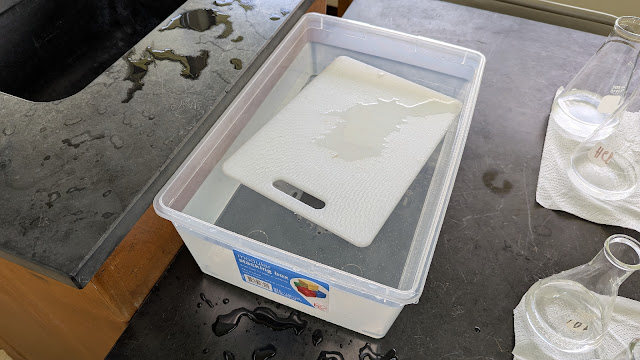Botany lab seven celery xylem conduction
Last year this laboratory was a fail. Little to no conduction.This year changes in the procedure created results that outperformed expectations..
The starting place was three bundles of celery. Two old bundles that looked battered, brown spotted, and dead. Concerned that the celery was no good, a third bundle was picked up from A1mart, one that was bright green and floppy. The floppiness was concerning, but this would prove to be ideal. The floppiness was due to dehydration. The fresh green color was indicative of the celery still being viable. When put into food dyed water, these stalks very quickly took up the dyed water.
A decision was made to switch to Erlenmeyer flasks and a single stack per pair. 109 ml of water in each. Dye was poured in: the red food color dye did not have a nozzle. Rulers, paring knives.
Cutting was done underwater on a cutting. Only the bottom was cut. The tops were left intact. Cuts were made on a shallow diagonal angle.
Notes on board covered the issues encountered last year along with countermeasures and mitigations.
Students were instructed to use stalks with leaves where possible. This resulted in the use of inner stalks.
Board diagrams and a proposed method for determining how far up the dyed water had gone after 60 minutes.
Within 15 minutes color changes the full length of the stalk were clearly visible. There was going to be no need to wait 60 minutes nor would cutting be required to see that flow had occurred. The flow was most apparent in the inner stalks of the celery that was deemed to not have been in good condition.
By 20 to 30 montes dye was appearing in the leaf venation. The food dye was clearly not particularly problematic as suggested on the board. The speed of flow up the xylem was unexpected. Cutting underwater is thought to have been the critical change in the procedure.
Blue dye was also rapidly appearing on the leaf tips of the green celery. This was happening within 15 minutes as well.
That dye rise was visible and quickly so suggests a revision to time until the dye reaches the leaf bases. Then measure the length in situ.
These two stalks started out the same color.
The green stems did not externally show the color change as well as the pale stems, but the flow was still clearly visible.
The pale stems showed clear, strong conduction.
The blue dye was, if anything, more motile than the red dye. The blue mottling in the leaves is real.
Only one group worked without leaves on their stalk and they still obtained results, albeit after 30 minutes. This suggests that with leaves could be pitted against without leaves to show that leaves result in a higher flow rate in the xylem.


















Comments
Post a Comment